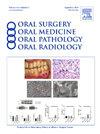下颌骨软骨粘液样纤维瘤1例
IF 1.9
3区 医学
Q2 DENTISTRY, ORAL SURGERY & MEDICINE
Oral Surgery Oral Medicine Oral Pathology Oral Radiology
Pub Date : 2025-07-21
DOI:10.1016/j.oooo.2025.04.032
引用次数: 0
摘要
软骨粘液样纤维瘤是一种极为罕见的良性肿瘤,在所有骨肿瘤中所占比例不到1%。它有轻微的男性优势;男性受影响的频率大约是女性的1.5倍。尽管通常影响患者在生命的第二和第三个十年,但确实存在50岁及以上患者的报告。软骨粘液样纤维瘤明显倾向于下肢长骨的干骺端,也常见于足部和髂骨的小骨。颅面骨、肋骨、脊柱和手、脚的短管骨的病变则不太常见。本文报告一例下颌骨软骨粘液样纤维瘤。病例报告:48岁男性左下颌骨发现多室放射性病变,并提交UKCD口腔病理活检服务,临床放射鉴别诊断包括成釉细胞瘤和牙源性角化囊肿。经组织病理学检查,可见一个由粘液瘤和软骨样区组成的碎片状假叶状肿块,中间有含有稀疏多核巨细胞的高细胞单核组织。黏液样区周围有饱满和星状梭形细胞。MDM2免疫组化结果为阴性,基本上排除了低级别中枢性骨肉瘤的可能性。结论:本病例的表现对这种罕见的实体发生在一个明显不常见的位置的文献有重要的补充,并强调了这种实体作为颅面骨粘液样病变的组织病理学鉴别诊断的考虑因素。本文章由计算机程序翻译,如有差异,请以英文原文为准。
Chondromyxoid fibroma of the mandible: report of a case
Introduction
The chondromyxoid fibroma is an exceedingly rare benign tumor, representing less than 1% of all bone tumors. It has a slight male preponderance; males are affected approximately 1.5 times more often than females. Though typically affecting patients during the second and third decades of life, reports of patients who are 50 years and older do exist. With a distinct predilection for the metaphyseal regions of the long bones of the lower extremities, the chondromyxoid fibroma has also commonly been reported in the small bones of the feet and the ilium. Much less common are lesions of the craniofacial bones, ribs, spine, and short tubular bones of the hands and feet. Herein, a case of chondromyxoid fibroma of the mandible is reported.
Case Report
A multilocular radiolucent lesion was noted in the left mandible of a 48-year-old male, and submitted to the UKCD Oral Pathology Biopsy service with a clinico-radiographic differential diagnosis including ameloblastoma and odontogenic keratocyst. Upon histopathologic examination, a fragmented, but pseudolobulated mass composed of myxomatous and chondroid areas with intervening zones of hypercellular mononuclear tissue containing sparse multinucleated giant cells, was appreciated. The myxoid areas contained both plump and stellate spindled cells at the periphery. Immunohistochemistry for MDM2 was negative, essentially excluding the possibility of a low-grade central osteosarcoma.
Conclusions
Presentation of this case represents a significant addition to the literature of this rare entity occurring in a distinctly uncommon location, and highlights this entity as a consideration in the histopathological differential diagnosis of myxoid lesions of the craniofacial bones.
求助全文
通过发布文献求助,成功后即可免费获取论文全文。
去求助
来源期刊

Oral Surgery Oral Medicine Oral Pathology Oral Radiology
DENTISTRY, ORAL SURGERY & MEDICINE-
CiteScore
3.80
自引率
6.90%
发文量
1217
审稿时长
2-4 weeks
期刊介绍:
Oral Surgery, Oral Medicine, Oral Pathology and Oral Radiology is required reading for anyone in the fields of oral surgery, oral medicine, oral pathology, oral radiology or advanced general practice dentistry. It is the only major dental journal that provides a practical and complete overview of the medical and surgical techniques of dental practice in four areas. Topics covered include such current issues as dental implants, treatment of HIV-infected patients, and evaluation and treatment of TMJ disorders. The official publication for nine societies, the Journal is recommended for initial purchase in the Brandon Hill study, Selected List of Books and Journals for the Small Medical Library.
 求助内容:
求助内容: 应助结果提醒方式:
应助结果提醒方式:


